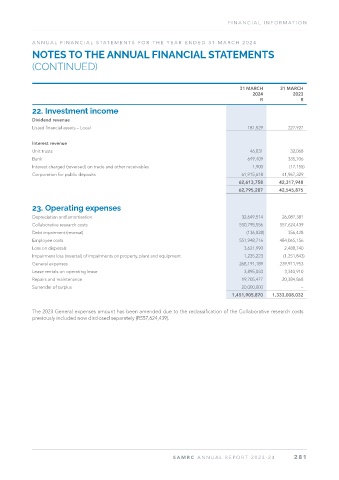Page 283 - SAMRC Annual Report 2024-2025
P. 283
FINANCIAL INFORMATION
ANNUAL FINANCIAL STATEMENTS FOR THE YEAR ENDED 31 MARCH 2025
SIGNIFICANT ACCOUNTING POLICIES
(CONTINUED)
1.14 Impairment of non-cash-generating assets (continued)
Restoration cost approach
Restoration cost is the cost of restoring the service potential of an asset to its pre-impaired level. The
present value of the remaining service potential of the asset is determined by subtracting the estimated
restoration cost of the asset from the current cost of replacing the remaining service potential of the
asset before impairment. The latter cost is determined as the depreciated reproduction or replacement
cost of the asset, whichever is lower.
Recognition and measurement
If the recoverable service amount of a non-cash-generating asset is less than its carrying amount, the carrying
amount of the asset is reduced to its recoverable service amount. This reduction is an impairment loss.
An impairment loss is recognised immediately in surplus or deficit.
When the amount estimated for an impairment loss is greater than the carrying amount of the
non-cash-generating asset to which it relates, the entity recognises a liability only to the extent that is a
requirement in the Standards of GRAP.
After the recognition of an impairment loss, the depreciation (amortisation) charge for the
non-cash-generating asset is adjusted in future periods to allocate the non-cash-generating asset’s revised
carrying amount, less its residual value (if any), on a systematic basis over its remaining useful life.
Reversal of an impairment loss
The entity assesses at each reporting date whether there is any indication that an impairment loss
recognised in prior periods for a non-cash-generating asset may no longer exist or may have decreased.
If any such indication exists, the entity estimates the recoverable service amount of that asset.
An impairment loss recognised in prior periods for a non-cash-generating asset is reversed if there has
been a change in the estimates used to determine the asset’s recoverable service amount since the last
impairment loss was recognised. The carrying amount of the asset is increased to its recoverable service
amount. The increase is a reversal of an impairment loss. The increased carrying amount of an asset
attributable to a reversal of an impairment loss does not exceed the carrying amount that would have
been determined (net of depreciation or amortisation) had no impairment loss been recognised for the
asset in prior periods.
A reversal of an impairment loss for a non-cash-generating asset is recognised immediately in surplus
or deficit.
After a reversal of an impairment loss is recognised, the depreciation (amortisation) charge for the
non-cash-generating asset is adjusted in future periods to allocate the non-cash-generating asset’s
revised carrying amount, less its residual value (if any), on a systematic basis over its remaining useful life.
1.15 Employee benefits
Employee benefits are all forms of consideration given by SAMRC in exchange for services rendered by
employees. An annual valuation of the SAMRC Pension Fund and Post Retirement Medical Aid is performed.
SAMRC ANNUAL REPOR T 2025-26 281

